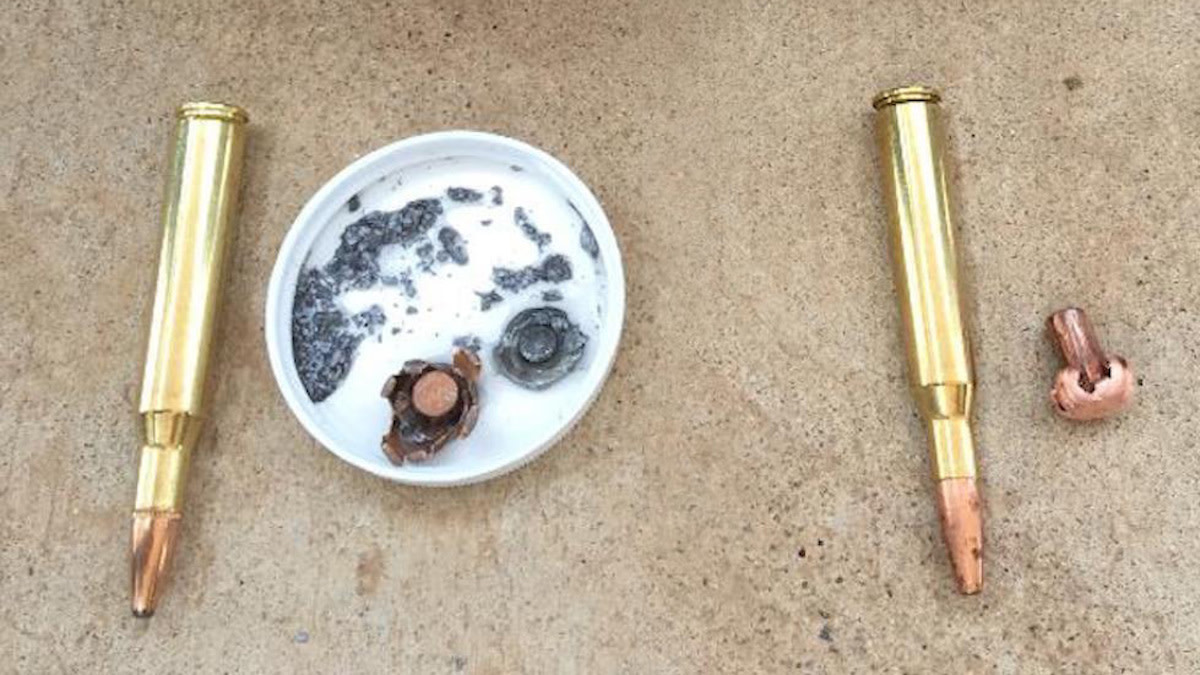
We know lead is a toxin, and we know the list of animals that have fallen ill from lead poisoning is a long one. This is not disputed, but we must differentiate between the science of lead poisoning and statements driven by advocacy intended to influence policy changes.
The issue of lead ammunition as it relates to wildlife conservation is so complex it should be broken up into bite-sized pieces. Pat Durkin covered the issue of non-lead bullet performance and availability in a previous article, but there are four additional issues that are often oversimplified or exaggerated: species affected, wildlife population-level effects, human health, and how these conversations relate to the future of hunting.
Affected Species
Many species have been documented to feed on carcasses shot with lead, but birds are most commonly affected by lead ingestion problems because their digestive systems hold fragments and grind them for long periods. We have known for a long time that lead ammunition ingestion by endangered California condors is negatively affecting their recovery.
Other than condors, few other species are so affected by lead ammunition ingestion that intervention for conservation purposes is warranted. Because of this, it is important to be accurate, stick to the science, and refrain from implying this is a problem for all "wildlife." Lead ammunition ingestion does not affect more than an occasional individual mammal, reptile, and amphibian under unusual circumstances. You can find documentation of environmental lead in mammals, amphibians, and reptiles, from local skeet shooting ranges used for decades or other sources like mines. But it would not make sense to use those uncommon cases to support regulatory restrictions on using lead ammunition.
We need to talk specifically about what the problem really is and not use evidence from unrelated sources of lead to imply lead ammunition is a problem for all categories of wildlife. If there is no evidence of bullet fragments and shot causing widespread conservation issues in non-bird species, then we should be cautious of advocates and wildlife professionals who try to blur the lines and talk vaguely about “lead exposure in wildlife.”
Population-Level Effects
Unlike most wildlife, condors are an endangered species. Every individual in the population is important, and any additional source of mortality can make a difference in whether that species persists. For other raptor species, concern over the use of lead ammunition is often framed in a conversation about conservation. In reality, the concern is for individual birds that ingest lead that was once a projectile. I was once fond of saying that, other than condors, there is no evidence of population-level effects from lead ingestion. Unfortunately, we are not monitoring raptor populations intensively enough to know that for certain. Also, if lead ingestion reduces a population by 1% or reduces its ability to increase at a faster rate, it is causing a population-level effect.
New information on eagles has sparked a renewed conversation about the effects of lead beyond the individual animal to population effects. Bald eagles were taken off the endangered species list in 2007, and their population continues to increase dramatically throughout the U.S. But research in seven northeastern states found that 30.6% of dead and dying eagles had detectable levels of lead in their tissues. This sounds concerning, but remember this is a sample of birds that were already dead and dying and not a sample of the eagle population. Computer models in that research estimated a 4-6% reduction in the population growth rate (reduction in the rate of increase, not reduction in population). This is certainly a population-level effect, but does it require intervention by wildlife professionals to make all hunters change to non-lead ammo so the booming eagle population can increase 4-6% faster? Would we reduce highway vehicle speeds if we could increase abundant eastern whitetail populations 4-6% faster?
Proving a population-level effect on a wildlife species is not always the threshold that triggers regulatory changes. Lead shotshells for waterfowl hunting were banned in the U.S. in 1991, but not out of concern for waterfowl populations (lead poisoning was only adding an estimated 2-3% to the overall mortality rate). The ban was actually forced by legal action because individual endangered (at the time) bald eagles were dying from ingesting ducks containing lead pellets. This illustrates why it may not be smart for hunters to dig in and demand significant population-level impacts before considering a switch to nonlead ammo.
If there are local issues with lead ingestion, they can and should be addressed through specific local regulation by state agencies. For example, if there is a lot of prairie dog shooting in a certain valley, and it happens to be a raptor migration corridor, we may have a local problem that has to be managed. State, provincial, or tribal wildlife agencies can address that local issue first with education and voluntary efforts to switch to non-lead ammunition and then with local regulation if needed. State wildlife agencies do this all the time–identify a problem that requires rectifying and then construct specific regulations to fix that problem. Agencies and lawmakers should not regulate hunters to switch to non-lead ammunition unless it can be demonstrated there is a conservation problem of such severity to the persistence and self-sustainability of a wildlife population that intervention is necessary to resolve the problem.
Human Health
Lead can be found in an inorganic metallic form (the gray lead we normally think of) as well as in an organic form used in various lead compounds. Most lead exposure in humans comes from organic lead compounds like lead additives in gasoline, lead paint, cartridge primers, and certain industrial compounds. Organic lead compounds have properties that make them easily absorbed through the skin, mucus membranes, and lung tissue. Metallic lead used in most bullets, however, is much harder for the body to absorb and rarely happens through the skin.
For many years, groups and individuals have been sounding the alarm that hunters are at risk of lead poisoning from ammunition fragments in game meat. There are even scientific papers that cite human health issues from highly absorbable organic lead compounds and then make the inappropriate leap to claim that metallic lead fragments eaten occasionally by hunters are a serious “potential” health issue. However, an objective review of the peer-reviewed human medical literature demonstrates that you would have to consume metallic lead almost daily to raise your blood lead level above a concerning threshold. Harmful human blood lead levels from lead ammunition come from rare and unusual cases, such as when kids intentionally eat pieces of lead, when shotgun pellets accumulate in a person’s appendix, gunshot victims with bullets lodged near a joint, a New Zealander who ate lead-shot meat daily, and Greenlanders who ate lead in sea ducks almost daily. These unusual cases do not represent 99% of hunters eating game meat periodically (and most of it lead free).
A survey in Minnesota found only 2% of packages of whole cuts contained lead and another found that 92% of hunter-ground packages of burger were lead free. Nevertheless, professionals who have not looked carefully at the science still claim that eating game meat harvested with lead is a health hazard. Some make these claims due to ignorance, and others because they don’t want anything to get in the way of them using this as another arrow in their advocacy quiver.
We hear health warnings about limiting fish intake because of heavy metals, but note that well-read medical professionals and toxicologists are not warning against eating meat shot with lead ammunition. This is because the available scientific evidence indicates eating game meat harvested with lead ammunition presents minimal human health risk unless consumed almost daily.
There are legitimate reasons for hunters to think about all their sources of lead exposure and do all they can to minimize it. My own blood lead levels are consistently high because I shoot pistols competitively and reload my own ammo. My family has used only copper bullets in all our hunting rifles and pistols for the last dozen years because they shoot well in our guns and waste less meat.
Whether you switch to non-lead ammunition is your decision. You may be uncomfortable with the thought you could unintentionally kill a single hawk. Also, if you serve venison frequently to your wife of child-bearing age or kids, you may view the risk of lead differently than a single person eating venison occasionally.
Hunter Image
No doubt, this issue is potentially a black eye for hunters, especially when some have been exaggerating the negative effects of lead ammunition as it relates to wildlife conservation. We do have to admit that hunters are killing and sickening individual birds and that can make us look bad.
Currently, about 95% of the public does not hunt and yet, 77-81% support legal, ethical hunting because they see it as a positive force for conservation. Some start to question their support when they see videos of the symbol of America near death as the narrator explains that hunters are killing eagles because they refuse to stop using lead bullets. We know the impossibility of everyone switching rapidly to non-lead ammo, but that detail is never included in the narrative.
There is an increasing level of empathy for individual animals (not populations) in the minds of the public, and wildlife agencies and hunters should be paying attention to public perception and values more than we have in the past. This rise in empathy is on a crash course with our traditional focus on population-level effects. I’m afraid throwing down the “population-level effects” card is going to become less and less effective in winning arguments. Regardless of whether lead ammunition is a serious conservation concern, we should be making proactive and voluntary steps to reduce the use of lead ammunition to lower unintentional raptor mortality and maintain the current support for hunting. I don’t believe government agencies should be banning lead ammo to save individuals, but I would like to see hunters out in front on this issue to preserve the public image of hunting, our conservation relevancy, and widespread support for hunting.
Intellectual Honesty and Appropriate Advocacy
It’s not appropriate to be advocating for wide-sweeping and logistically impossible regulatory changes without a clearly articulated and well-supported conservation need related to the sustainability or conservation of a species.
The argument that regulatory action is needed to restrict lead ammunition use is not at all compelling from a conservation perspective. If agencies or advocates try to bluff their way forward with general and unsupported statements to promote a ban on the use of lead ammunition, they should not be surprised by the strong resistance. Urging hunters to voluntarily switch through education and incentives is a much better and well-supported path than exaggerating the effects of lead “exposure” on wildlife or speculating about unknown population-level effects.
One of the seven tenets of the North American Model of Wildlife Conservation is, “Science is the proper tool for discharge of wildlife policy.” That tenant has been foundational to the most successful system of wildlife conservation on the planet. We must hold decision-makers accountable to that when discussing the use of lead ammunition. I am not pro- or anti-lead ammo, but I would like the conversation to be based on reliable, unbiased science and not spun to push a desired outcome. Advocacy should be based on science–science should not be shaped by advocacy for policy change.





